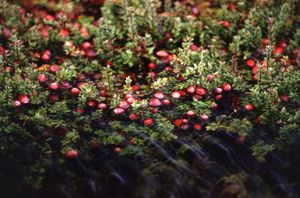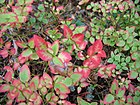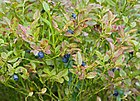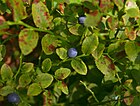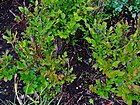Note: This is a project under development. The articles on this wiki are just being initiated and broadly incomplete. You can Help creating new pages.
Difference between revisions of "Vaccinium - Karamarda"
m (Prabhakar moved page Karamarda(Cranberry) to Karamarda (Vaccinium)) |
(→Chemical Composition) |
||
| (12 intermediate revisions by 2 users not shown) | |||
| Line 1: | Line 1: | ||
[[File:Cranberry bog.jpg|thumb|right|Karamarda(Cranberry)]] | [[File:Cranberry bog.jpg|thumb|right|Karamarda(Cranberry)]] | ||
| + | '''Cranberries''' are a group of evergreen dwarf shrubs or trailing vines in the subgenus Oxycoccus of the genus Vaccinium. | ||
| + | ==Uses== | ||
| + | {{Uses|Lower blood pressure}}, {{Uses|Diabetes}}, {{Uses|Hemorrhoids}}, {{Uses|Varicose veins}}, {{Uses|Angina}}, {{Uses|Cancer}}, {{Uses|Kidney stones}}, {{Uses|Diarrhea}}, {{Uses|Blood pressure}} | ||
| + | |||
| + | ==Parts Used== | ||
| + | {{Parts Used|Fruits}}, {{Parts Used|Leaves}}. | ||
| + | |||
| + | ==Chemical Composition== | ||
| + | It contains chrysoeriol, scopoletin, trans-p-hydroxycinnamic acid, trans-p-hydroxycinnamic acid ethyl ester, cafeic acid ethyl ester, beta-sitosterol, iuteolin, quercetin, esculetin , cafeic acid, isolariciresinol-9-O-beta-D-xyloside, 10-O-trans-p-coumaroylsandoside<ref name="chemical composition"/> | ||
| + | |||
| + | ==Common names== | ||
| + | {{Common names|kn=Anduvan|ml=Kelamaram|sa=|ta=Anduvan|te=|hi=|en=Indian Cranberry}} | ||
| + | |||
| + | ==Properties== | ||
| + | Reference: Dravya - Substance, Rasa - Taste, Guna - Qualities, Veerya - Potency, Vipaka - Post-digesion effect, Karma - Pharmacological activity, Prabhava - Therepeutics. | ||
| + | ===Dravya=== | ||
| + | |||
| + | ===Rasa=== | ||
| + | Tikta (Bitter), Kashaya (Astringent) | ||
| + | ===Guna=== | ||
| + | Laghu (Light), Ruksha (Dry), Tikshna (Sharp) | ||
| + | ===Veerya=== | ||
| + | Ushna (Hot) | ||
| + | ===Vipaka=== | ||
| + | Katu (Pungent) | ||
| + | ===Karma=== | ||
| + | Kapha, Vata | ||
| + | ===Prabhava=== | ||
| + | |||
| + | ==Habit== | ||
| + | {{Habit|Deciduous Shrub}} | ||
| − | + | ==Identification== | |
| + | ===Leaf=== | ||
| + | {{Leaf|Simple||The leaves are ovate, in an irregular oval or slightly egg shape that is wider at the bottom than the top}}<ref name="Leaf"/> | ||
| + | |||
| + | ===Flower=== | ||
| + | {{Flower|Unisexual|0.33" long|White to very light pink|5-20|Blooms are typically numerous and somewhat showy and Bloom time is May}} | ||
| + | |||
| + | ===Fruit=== | ||
| + | {{Fruit|Blue-black berry|0.25" to 0.5" diameter|Eaten readily by wildlife and humans|Ripen July through August|1}} | ||
| + | |||
| + | ===Other features=== | ||
| + | |||
| + | ==List of Ayurvedic medicine in which the herb is used== | ||
| + | |||
| + | ==Where to get the saplings== | ||
| + | ==Mode of Propagation== | ||
| + | {{Propagation|Seeds}}. | ||
| + | |||
| + | ==How to plant/cultivate== | ||
| + | Landscape Uses: Border, Massing, Seashore. Requires a moist but freely-draining lime free soil, preferring one that is rich in peat or a light loamy soil with added leaf-mould<ref name="How to plant/cultivate"/> | ||
| + | |||
| + | ==Commonly seen growing in areas== | ||
| + | {{Commonly seen|Swamps}}, {{Commonly seen|Low wet woods}}, {{Commonly seen|Pine barrens}}, {{Commonly seen|Dry uplands}}. | ||
| − | == | + | ==Photo Gallery== |
| + | <gallery class="left" caption="" widths="140px" heights="140px"> | ||
| + | File:Конново 2007 (0003).jpg|Fruit | ||
| + | File:Myrtilles sauvages en Ardèche.JPG | ||
| + | File:vaccinium_myrtillus.jpeg|Typical habitus | ||
| + | File:Blueberry-leaves-in-autumn FI-EU 2007-Sep-30 by-RAM.jpg|Leaves starting to change colour in autumn | ||
| + | File:Myrtille Vaccinium myrtillus.jpg | ||
| + | File:Vaccinium myrtillus pl.jpg | ||
| + | File:Vaccinium myrtillus IM4821 Mustikka C.JPG|Leafless plant early in the spring | ||
| + | File:Vaccinium_myrtillus_001.JPG | ||
| + | </gallery> | ||
| − | + | ==References== | |
| − | |||
| − | |||
| − | + | <references> | |
| + | <ref name="chemical composition">[https://www.ncbi.nlm.nih.gov/pubmed/19160790 Chemical constituents]</ref> | ||
| − | + | <ref name="Leaf">[http://hort.uconn.edu/detail.php?pid=517 Plant morphology]</ref> | |
| − | |||
| − | |||
| − | == | + | <ref name="How to plant/cultivate">[https://www.pfaf.org/user/Plant.aspx?LatinName=Vaccinium+corymbosum Cultivation details]</ref> |
| + | </references> | ||
| − | *[https:// | + | ==External Links== |
| + | * [https://www.sciencedirect.com/topics/agricultural-and-biological-sciences/vaccinium-myrtillus Vaccinium on science direct] | ||
| + | * [https://onlinelibrary.wiley.com/doi/abs/10.1111/jfbc.12414 Vaccinium on online library.wiley.com ] | ||
| + | * [http://homeguides.sfgate.com/grow-vaccinium-myrtillus-47553.html How to Grow Vaccinium Myrtillus] | ||
| + | * [https://www.researchgate.net/publication/220005144_The_European_blueberry_Vaccinium_myrtillus_L_and_the_potential_for_cultivation_A_review The European blueberry (Vaccinium myrtillus L.) and the potential for cultivation] | ||
[[Category:Herbs]] | [[Category:Herbs]] | ||
| + | [[Category:Ericaceae]] | ||
Latest revision as of 21:57, 31 August 2020
Cranberries are a group of evergreen dwarf shrubs or trailing vines in the subgenus Oxycoccus of the genus Vaccinium.
Contents
- 1 Uses
- 2 Parts Used
- 3 Chemical Composition
- 4 Common names
- 5 Properties
- 6 Habit
- 7 Identification
- 8 List of Ayurvedic medicine in which the herb is used
- 9 Where to get the saplings
- 10 Mode of Propagation
- 11 How to plant/cultivate
- 12 Commonly seen growing in areas
- 13 Photo Gallery
- 14 References
- 15 External Links
Uses
Lower blood pressure, Diabetes, Hemorrhoids, Varicose veins, Angina, Cancer, Kidney stones, Diarrhea, Blood pressure
Parts Used
Chemical Composition
It contains chrysoeriol, scopoletin, trans-p-hydroxycinnamic acid, trans-p-hydroxycinnamic acid ethyl ester, cafeic acid ethyl ester, beta-sitosterol, iuteolin, quercetin, esculetin , cafeic acid, isolariciresinol-9-O-beta-D-xyloside, 10-O-trans-p-coumaroylsandoside[1]
Common names
| Language | Common name |
|---|---|
| Kannada | Anduvan |
| Hindi | |
| Malayalam | Kelamaram |
| Tamil | Anduvan |
| Telugu | |
| Marathi | NA |
| Gujarathi | NA |
| Punjabi | NA |
| Kashmiri | NA |
| Sanskrit | |
| English | Indian Cranberry |
Properties
Reference: Dravya - Substance, Rasa - Taste, Guna - Qualities, Veerya - Potency, Vipaka - Post-digesion effect, Karma - Pharmacological activity, Prabhava - Therepeutics.
Dravya
Rasa
Tikta (Bitter), Kashaya (Astringent)
Guna
Laghu (Light), Ruksha (Dry), Tikshna (Sharp)
Veerya
Ushna (Hot)
Vipaka
Katu (Pungent)
Karma
Kapha, Vata
Prabhava
Habit
Identification
Leaf
| Kind | Shape | Feature |
|---|---|---|
| Simple | The leaves are ovate, in an irregular oval or slightly egg shape that is wider at the bottom than the top |
Flower
| Type | Size | Color and composition | Stamen | More information |
|---|---|---|---|---|
| Unisexual | 0.33" long | White to very light pink | 5-20 | Blooms are typically numerous and somewhat showy and Bloom time is May |
Fruit
| Type | Size | Mass | Appearance | Seeds | More information |
|---|---|---|---|---|---|
| Blue-black berry | 0.25" to 0.5" diameter | Eaten readily by wildlife and humans | Ripen July through August | 1 | {{{6}}} |
Other features
List of Ayurvedic medicine in which the herb is used
Where to get the saplings
Mode of Propagation
How to plant/cultivate
Landscape Uses: Border, Massing, Seashore. Requires a moist but freely-draining lime free soil, preferring one that is rich in peat or a light loamy soil with added leaf-mould[3]
Commonly seen growing in areas
Swamps, Low wet woods, Pine barrens, Dry uplands.
Photo Gallery
References
External Links
- Ayurvedic Herbs known to be helpful to treat Lower blood pressure
- Ayurvedic Herbs known to be helpful to treat Diabetes
- Ayurvedic Herbs known to be helpful to treat Hemorrhoids
- Ayurvedic Herbs known to be helpful to treat Varicose veins
- Ayurvedic Herbs known to be helpful to treat Angina
- Ayurvedic Herbs known to be helpful to treat Cancer
- Ayurvedic Herbs known to be helpful to treat Kidney stones
- Ayurvedic Herbs known to be helpful to treat Diarrhea
- Ayurvedic Herbs known to be helpful to treat Blood pressure
- Herbs with Fruits used in medicine
- Herbs with Leaves used in medicine
- Herbs with common name in Kannada
- Herbs with common name in Malayalam
- Herbs with common name in Tamil
- Herbs with common name in English
- Habit - Deciduous Shrub
- Index of Plants which can be propagated by Seeds
- Herbs that are commonly seen in the region of Swamps
- Herbs that are commonly seen in the region of Low wet woods
- Herbs that are commonly seen in the region of Pine barrens
- Herbs that are commonly seen in the region of Dry uplands
- Herbs
- Ericaceae
